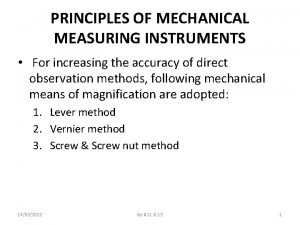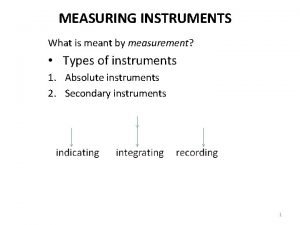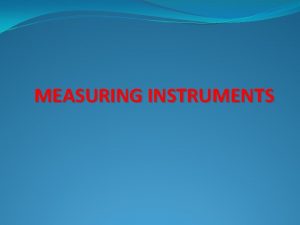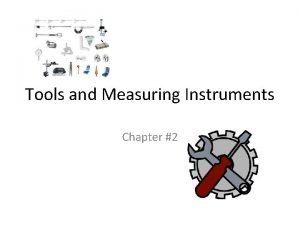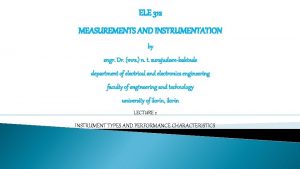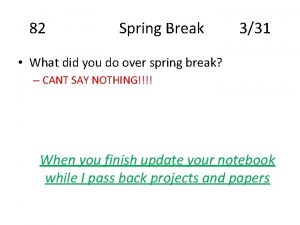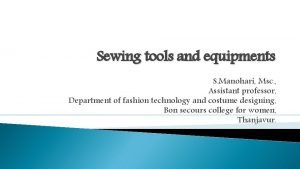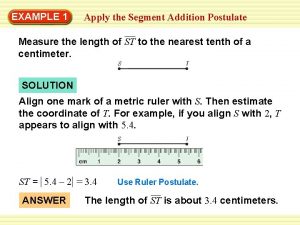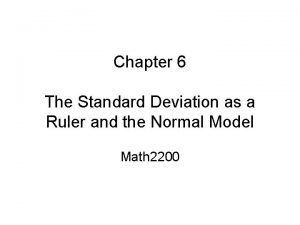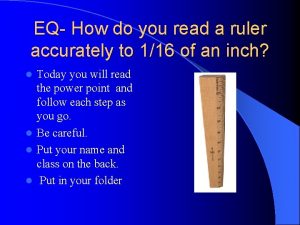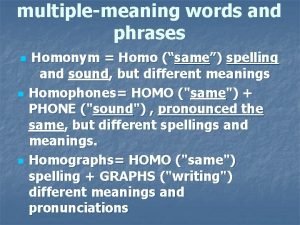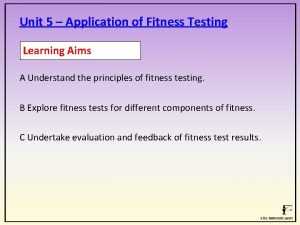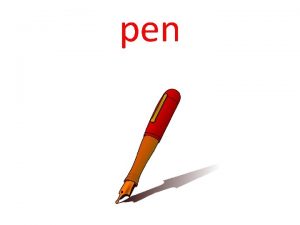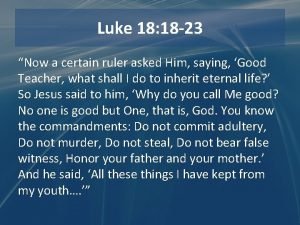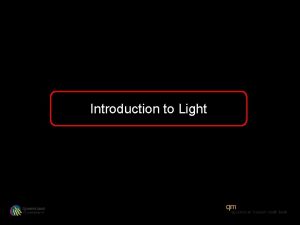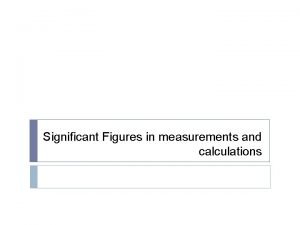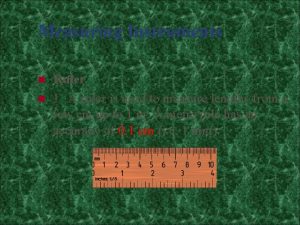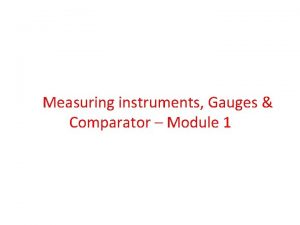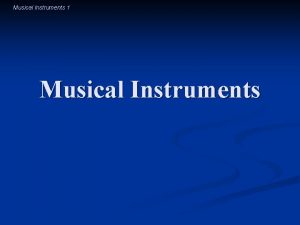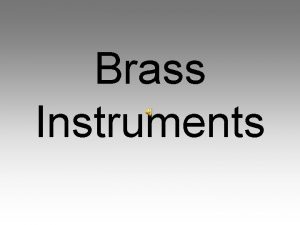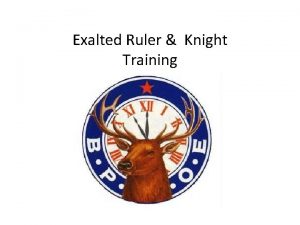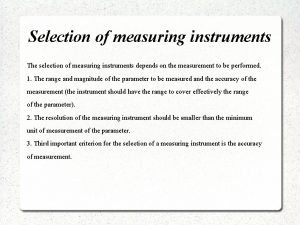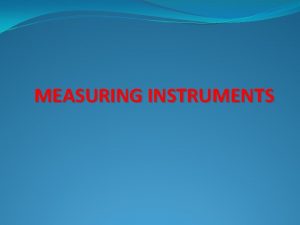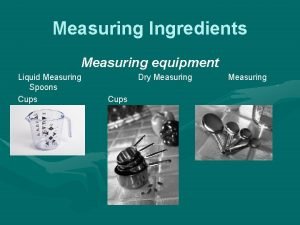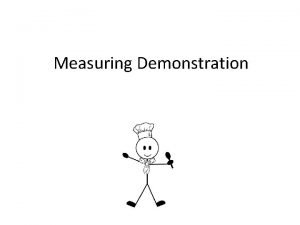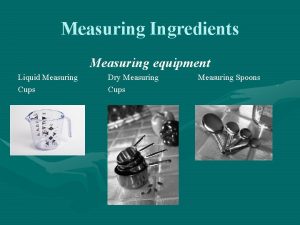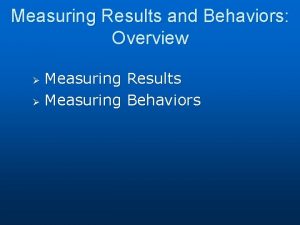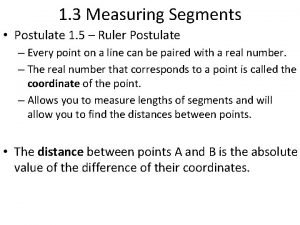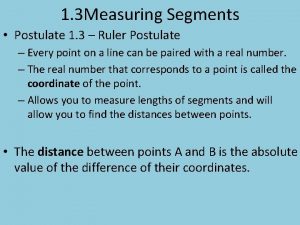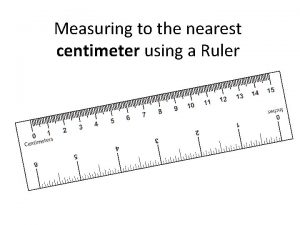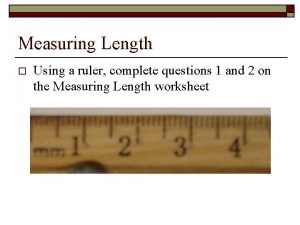Measuring Instruments n n Ruler 1 A ruler








































- Slides: 40

Measuring Instruments n n Ruler 1 A ruler is used to measure lengths from a few cm up to 1 m. A metre rule has an accuracy of 0. 1 cm (i. e. 1 mm).

Measuring Instruments n n Ruler 2 Precautions to be taken when using a ruler: (a) Ensure that the object is in contact with the ruler to avoid inaccurate readings. (b) Avoid parallax errors.

Measuring Instruments n n Ruler Parallax errors in measurement arise as a result of taking a reading, with the eye of the observer in the wrong position with respect to the scale of the ruler. Figure 1. 7 shows the correct position of the eye when reading the scale. Error = 0. 1 cm

Measuring Instruments n n n Ruler (c) Avoid zero and errors. The ends of a ruler, which may be worn out, are a source of errors in measurement. Thus it is advisable to use the division mark `1' of the scale as the zero point when taking a measurement.

Measuring Instruments n Ruler n (c) Length of the block, l =3. 2 cm-1. 0 cm = 2. 2 cm

Measuring Instruments Vernier Caliper n 1 Lengths smaller than 1 mm can be measured with the help of an instrument called a vernier caliper.

Measuring Instruments n n Vernier Caliper 2 A vernier caliper is used to measure an object with dimensions up to 12 cm with an accuracy of 0. 01 cm.

Measuring Instruments n n Vernier Caliper 3 There are two pairs of jaws, one is designed to measure linear dimensions and external diameters while the other is to measure internal diameters.

Measuring Instruments n n Vernier Caliper 4. To measure with a vernier caliper, slide the vernier scale along the main scale until the object is held firmly between the jaws of the caliper. The subsequent steps are as follows.

Measuring Instruments n Vernier Caliper n (a)The reading on the main scale is determined with reference to the `0' mark on the vernier scale. The reading to be taken on the main scale is the mark preceding the Figure 1. 10 shows that the '0' mark on the vernier scale lies between 3. 2 cm and 3. 3 cm. The reading to be taken on the main scale is 3. 2 cm (the `0' mark on the vernier scale acts as a pointer). 1

Measuring Instruments n Vernier Caliper n (b) The reading to be taken on the vernier scale is indicated by the mark on the vernier scale which is exactly in line or coincides with any main scale division line. Figure 1. 10 shows that the fourth mark on the vernier scale is exactly in line with a mark on the main scale. Thus the second decimal reading of the measurement is: Vernier scale reading = 4 x 0. 01 cm = 0. 04 cm n n 2

Measuring Instruments n n n Vernier Caliper 0. 04 3. 2 (c) The reading of the vernier caliper is the result of the addition of the reading on the main scale to the reading on the vernier scale.

Measuring Instruments n n n Vernier Caliper 0. 04 3. 2 (c) The reading of the vernier caliper is the result of the addition of the reading on the main scale to the reading on the vernier scale. Caliper reading = Main scale Reading + Vernier scale reading Thus the reading of the vernier caliper in Figure 1. 10 is = 3. 2 + 0. 04 = 3. 24 cm

Measuring Instruments n n Vernier Caliper 5. A vernier caliper has a zero error if the `0' mark on the main scale is not in line with the '0' mark on the vernier scale when the jaws of the caliper are fully closed

Measuring Instruments n n Vernier Caliper (a) Positive zero error Zero error = +0. 04 cm.

Measuring Instruments 0. 02 cm 0. 70 cm 0. 72 cm

Measuring Instruments Vernier Caliper (b) Negative zero error n Zero error = -0. 02 cm. n

What is the result of measuring ?

What does it mean ?

6 mm

What does it mean ?

( 2 x 0. 1 ) mm

6 mm ( 2 x 0. 1 ) mm The result of measuring is ( 6 mm + 0. 2 mm ) = 6. 2 mm

What is the result of measuring ?

The result of measuring is : ( 3 mm + ( 7 x 0. 1 ) mm ) = 3. 7 mm

Measuring Instruments n Micrometer Screw Gauge 1 A micrometer screw gauge is used to measure small lengths ranging between 0. 10 mm and 25. 00 mm.

Measuring Instruments Micrometer Screw Gauge 2 This instrument can be used to measure diameters of wires and thicknesses of steel plates to an accuracy of 0. 01 mm. n

Measuring Instruments n 3 Micrometer Screw Gauge The micrometer scale comprises a main scale marked on the sleeve and a scale marked on the thimble called the thimble scale.

Measuring Instruments Micrometer Screw Gauge 4 The difference between one division on the upper scale and one division on the lower scale is 0. 5 mm. n

Measuring Instruments Micrometer Screw Gauge 5 The thimble scale is subdivided into 50 equal divisions. When the thimble is rotated through one complete turn, i. e. 360 , the gap between the anvil and the spindle increases by 0. 50 mm.

Measuring Instruments Micrometer Screw Gauge 6 This means that one division on the thimble scale is = 0. 01 mm.

Measuring Instruments Micrometer Screw Gauge 7 When taking a reading, the thimble is turned until the object is gripped very gently between the anvil and the spindle.

Measuring Instruments Micrometer Screw Gauge 8 The ratchet knob is then turned until a `click' sound is heard.

Measuring Instruments Micrometer Screw Gauge 9 The ratchet knob is used to prevent the user from exerting undue pressure.

Measuring Instruments Micrometer Screw Gauge 10 The grip on the object must not be excessive as this will affect the accuracy of the reading.

Measuring Instruments Micrometer Screw Gauge 11 Readings on the micrometer are taken as follows. (a) The last graduation showing on the main scale indicates position between 2. 0 mm and 2. 5 mm. Thus the reading on the main scale is read as 2. 0 mm.

Measuring Instruments Micrometer Screw Gauge 11 Readings on the micrometer are taken as follows. (b) The reading of the micrometer screw gauge is the sun of the main scale reading and the thimble scale reading which is: n 2. 0 + 0. 22 =2. 22 mm

Measuring Instruments Micrometer Screw Gauge 11 Readings on the micrometer are taken as follows. (b) The reading on the thimble scale is the point where the horizontal reference line of the main scale is in line with the graduation mark on the thimble scale Figure 1. 15(b) shows this to be the 22 nd mark on the thimble scale, thus giving a reading of 22 x 0. 01 mm = 0. 22 mm.

Measuring Instruments Micrometer Screw Gauge 12 Readings on the micrometer are taken as follows. (a) Positive zero error n In Figure 1. 16, the horizontal reference line in the main scale is in line with the 4 th division mark, on the positive side of the `0' mark, on the thimble scale. The error of +0. 04 mm must be subtracted from all readings taken. n Zero error = +0. 04 mm

Measuring Instruments Micrometer Screw Gauge 13(b) Negative zero error In Figure 1. 17, the horizontal reference line on the main scale is in line with the 3 rd division mark, below the `0' mark of the thimble scale. Zero error = -0. 03 mm
 Mechanical measuring devices
Mechanical measuring devices And passive instrument is
And passive instrument is Direct measuring instrument
Direct measuring instrument Uses of voltmeter
Uses of voltmeter Secondary instrument definition
Secondary instrument definition Measuring instruments directive
Measuring instruments directive Tools and measuring instruments chapter 2
Tools and measuring instruments chapter 2 Non linear measuring instruments
Non linear measuring instruments Pressure measuring devices
Pressure measuring devices Lion prince of mali
Lion prince of mali A specially waxed carbon paper
A specially waxed carbon paper Angle addition postulate formula
Angle addition postulate formula Is steak abiotic or biotic
Is steak abiotic or biotic Senguttuvan chera
Senguttuvan chera Using standard deviation as a ruler
Using standard deviation as a ruler Recursion trace diagram
Recursion trace diagram Readiness ruler motivational interviewing
Readiness ruler motivational interviewing Ancient greece balkan peninsula
Ancient greece balkan peninsula Ruler of all gods
Ruler of all gods Ruler small lines
Ruler small lines Apples countable or uncountable
Apples countable or uncountable Sun rose meaning
Sun rose meaning Systematic error
Systematic error Metric conversion ruler
Metric conversion ruler Sui tang song
Sui tang song Ray location postulate
Ray location postulate Divine approval for a chinese ruler
Divine approval for a chinese ruler Normative data for the ruler drop test
Normative data for the ruler drop test Cuban ruler
Cuban ruler Wall sit test normative data
Wall sit test normative data Readiness ruler worksheet
Readiness ruler worksheet Ruler pencil sharpener
Ruler pencil sharpener Song dynasty
Song dynasty Ruler drop test component of fitness
Ruler drop test component of fitness Breaking down an inch
Breaking down an inch Why was cyrus considered a fair ruler
Why was cyrus considered a fair ruler Certain ruler
Certain ruler The ruler of the land 618
The ruler of the land 618 Why can we represent light rays using a ruler
Why can we represent light rays using a ruler Feeling words curriculum
Feeling words curriculum Ruler significant figures
Ruler significant figures
